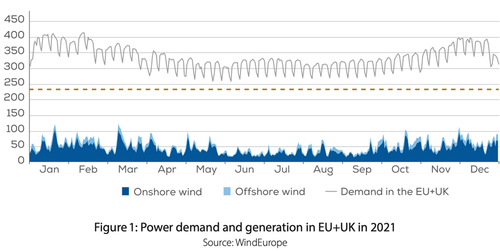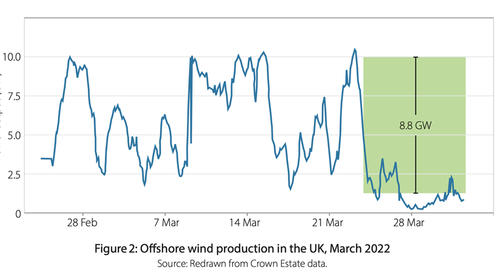Authored by Chris Morrison via DailySceptic.org,
It could be argued that the basic arithmetic showing wind power is an economic and societal disaster in the making should be clear to a bright primary school child. Now the Oxford University mathematician and physicist, researcher at CERN and Fellow of Keble College, Emeritus Professor Wade Allison has done the sums. The U.K. is facing the likelihood of a failure in the electricity supply, he concludes.
“Wind power fails on every count,” he says, adding that governments are ignoring “overwhelming evidence” of the inadequacies of wind power, “and resorting to bluster rather than reasoned analysis”.
Professor Allison’s dire warnings are contained in a short paper recently published by the Global Warming Policy Foundation. He notes that the energy provided by the Sun is “extremely weak”, which is why it was unable to provide the energy to sustain even a small global population before the Industrial Revolution with an acceptable standard of living. A similar point was made recently in more dramatic fashion by the nuclear physicist Dr. Wallace Manheimer. He argued that the infrastructure around wind and solar will not only fail, “but will cost trillions, trash large portions of the environment and be entirely unnecessary”.
In his paper, Allison concentrates on working out the numbers that lie behind the natural fluctuations in the wind. The full workings out are not complicated and can be assessed from the link above. He shows that at a wind speed of 20mph, the power produced by a wind turbine is 600 watts per square metre at full efficiency. To deliver the same power as the Hinkley Point C nuclear plant – 3,200 million watts – it would require 5.5 million square metres of turbine swept area.
It is noted that this should be quite unacceptable to those who care about birds and other environmentalists. Of course, this concern does not seem to have materialised to date. Millions of bats and birds are calculated to be slaughtered by onshore wind turbines every year. Meanwhile, off the coast of Massachusetts, work is about to start on a giant wind farm, complete with permits to harass and likely injure almost a tenth of the population of the rare North Atlantic Right whale.
When fluctuations in wind speed are taken into account in Allison’s formula, the performance of wind becomes very much worse. If the wind speed drops by half, the power available falls by a factor of eight. Almost worse, he notes, if the wind speed doubles, the power delivered goes up eight times, and the turbine has to be turned off for its own protection.
The effect of the enhanced fluctuations is dramatic, as shown in the graph above. The installed nominal generating capacity in the EU and U.K. in 2021, shown by the brown dashed line, was 236 GW, but the highest daily output was only 103 GW on March 26th. The unreliability is shown to even greater effect in the second graph that plots the wind generated offshore in the U.K. in March last year.
For eight days at the end of the month, power generation slumped, presumably, says Allison, because the wind speed halved. The 8.8 GW daily loss over the period was noted to be 1,000 times the capacity of the world largest grid storage battery at Moss Landings in California. When it comes to the enormous batteries needed to store renewable power, Allison notes the problems with safety, as well as mineral shortages. Batteries will never make good the failure of offshore wind farms, even for a week, and he points out they can fail for much longer than that.
Others have recently looked in more detail at the costs of battery storage. The American lawyer and mathematician Francis Menton, who runs the Manhattan Contrarian site, reviewed recent official cost reports and found that “even on the most optimistic assumptions” the cost could be as high as a country’s GDP. On less optimistic assumptions, the capital cost alone could be 15 times annual GDP. Last year, Associate Professor Simon Michaux warned the Finnish Government that there were not enough minerals in the world to supply all the batteries needed for Net Zero. Michaux observed that the Net Zero project may not go fully “as planned”. Meanwhile, Menton concluded, with an opinion that some might consider unduly charitable: “It is hard to avoid the conclusion that the people planning the Net Zero transition have no idea what they are doing.”
Professor Allison has done his sums based on basic physics and freely available information. “Whichever way you look at it, wind power is inadequate. It is intermittent and unreliable; it is exposed and vulnerable; it is weak with a short life-span,” he concludes.






